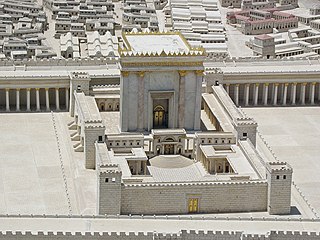Related Research Articles

Alexander Jannaeus was the second king of the Hasmonean dynasty, who ruled over an expanding kingdom of Judaea from 103 to 76 BCE. A son of John Hyrcanus, he inherited the throne from his brother Aristobulus I, and married his brother's widow, Queen Salome Alexandra. From his conquests to expand the kingdom to a bloody civil war, Alexander's reign has been described as cruel and oppressive with never-ending conflict. The major historical sources of Alexander's life are Josephus's Antiquities of the Jews and The Jewish War.
Year 103 BC was a year of the pre-Julian Roman calendar. At the time it was known as the Year of the Consulship of Marius and Orestes and the Second Year of Taichu. The denomination 103 BC for this year has been used since the early medieval period, when the Anno Domini calendar era became the prevalent method in Europe for naming years.
This article concerns the period 79 BC – 70 BC.

This article concerns the period 109 BC – 100 BC.
Year 63 BC was a year of the pre-Julian Roman calendar. At the time it was known as the Year of the Consulship of Cicero and Hybrida. The denomination 63 BC for this year has been used since the early medieval period, when the Anno Domini calendar era became the prevalent method in Europe for naming years.
Year 66 BC was a year of the pre-Julian Roman calendar. At the time it was known as the Year of the Consulship of Lepidus and Tullus. The denomination 66 BC for this year has been used since the early medieval period, when the Anno Domini calendar era became the prevalent method in Europe for naming years.
Year 30 BC was either a common year starting on Wednesday, Thursday or Friday or a leap year starting on Thursday of the Julian calendar and a common year starting on Wednesday of the Proleptic Julian calendar. At the time, it was known as the Year of the Consulship of Octavian and Crassus. The denomination 30 BC for this year has been used since the early medieval period, when the Anno Domini calendar era became the prevalent method in Europe for naming years.
Year 153 BC was a year of the pre-Julian Roman calendar. At the time it was known as the Year of the Consulship of Nobilior and Luscus. The denomination 153 BC for this year has been used since the early medieval period, when the Anno Domini calendar era became the prevalent method in Europe for naming years.

The Maccabees, also spelled Machabees, were a group of Jewish rebel warriors who took control of Judea, which at the time was part of the Seleucid Empire. They founded the Hasmonean dynasty, which ruled from 167 to 37 BCE, being a fully independent kingdom from 104 to 63 BCE. They reasserted the Jewish religion, expanded the boundaries of Judea by conquest, and reduced the influence of Hellenism and Hellenistic Judaism.

The Hasmonean dynasty was a ruling dynasty of Judea and surrounding regions during the Hellenistic times of the Second Temple period, from c. 140 BCE to 37 BCE. Between c. 140 and c. 116 BCE the dynasty ruled Judea semi-autonomously in the Seleucid Empire, and from roughly 110 BCE, with the empire disintegrating, Judea gained further autonomy and expanded into the neighboring regions of Perea, Samaria, Idumea, Galilee, and Iturea. The Hasmonean rulers took the Greek title basileus ("king") as the kingdom became a regional power for several decades. Forces of the Roman Republic intervened in the Hasmonean Civil War in 63 BCE and made it into a client state, marking the decline of Hasmonean dynasty; Herod the Great displaced the last reigning Hasmonean client-ruler in 37 BCE.

Salome Alexandra, or Shlomtzion, was a regnant queen of Judaea, one of only three women to rule over the country, the other two being Athaliah and Deborah. The wife of Aristobulus I, and afterward of Alexander Jannaeus, she was also the last ruler of Judaea to die as the sovereign of an independent kingdom. Her nine-year reign has been described as a "golden age" of Hasmonean history.

Herod Archelaus was the ethnarch of Samaria, Judea, and Idumea, including the cities Caesarea and Jaffa, for nine years. He was the son of Herod the Great and Malthace the Samaritan, brother of Herod Antipas, and half-brother of Herod II. Archelaus came to power after the death of his father Herod the Great in 4 BC, and ruled over one-half of the territorial dominion of his father. Archelaus was removed by the Roman emperor Augustus when Judaea province was formed under direct Roman rule, at the time of the Census of Quirinius.

Aristobulus II was the Jewish High Priest and King of Judea, 66 BCE to 63 BCE, from the Hasmonean dynasty.

John Hyrcanus II, a member of the Hasmonean dynasty, was for a long time the Jewish High Priest in the 1st century BCE. He was also briefly King of Judea 67–66 BCE and then the ethnarch (ruler) of Judea, probably over the period 47–40 BCE.

The Teacher of Righteousness is a mysterious figure found in some of the Dead Sea Scrolls at Qumran, most prominently in the Damascus Document. This document speaks briefly of the origins of the sect, probably Essenes, 390 years after the reign of Nebuchadnezzar captured Jerusalem. after another 20 years of looking blindly for the way; "God... raised for them a Teacher of Righteousness to guide them in the way of His heart".

Hasmonean coinage are the coins minted by the Hasmonean kings. Only bronze coins in various denominations have been found; the smallest being a prutah or a half prutah. Two Roman silver denarii are associated with the Hasmoneans; one has the inscription BACCIVS IVDAEAS; with its exact meaning unclear (short for "BASILEOS IUDAEAS", King Judas?). Both show a man thought to be Yehuda Aristobolus bowing before a camel with a palm branch in his hand.
Matthias I Ephlias was an ethnic Jew living in Jerusalem.

Battle of Gadara was fought between the Judaean Hasmoneans and the Arab Nabataeans around 93 BC in Gadara in modern-day Jordan.
The Judean Civil War was a conflict between King Alexander Jannaeus and the Pharisees, the dominant political party in the Great Sanhedrin at the time. Alexander was supported by the minority Sadducees, while the Pharisees under Nasi Joshua ben Perachiah were briefly backed by the Seleucid Empire.

The Second Temple period in Jewish history began with the end of the Babylonian captivity and the Persian conquest of the Near East in 539 BCE. The Second Temple was then built, and finished around 516 BCE. The conquests of Macedonia under Alexander the Great in 332 BCE saw Judea and the Near East placed under Greek influence during the Hellenistic period; Hellenistic Judaism blended both Greek and Jewish traditions. The Maccabean Revolt of 167–142 BCE was fight a first for Judean autonomy against a suppression of traditional Judaism, and later acquired outright independence under the rule of the Hasmonean family in an independent Hasmonean kingdom. The Hasmoneans would rule until 63 BCE, when they were reduced to client king status as Roman puppets; that too would end in 37 BCE, with King Herod the Great taking control, leading to the Herodian dynasty. Herod's death would lead to both the Herodian Tetrarchy where smaller regions ruled by members of his family, as well as direct Roman control by the governors of Roman Judea. The period would come to an end with the First Jewish–Roman War of 66–73 CE. Jerusalem was conquered in 70 CE, and the Second Temple was destroyed.